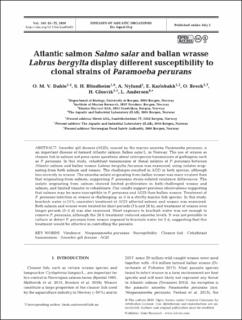| dc.contributor.author | Dahle, Ole Martin Vik | |
| dc.contributor.author | Blindheim, Steffen H. | |
| dc.contributor.author | Nylund, Are | |
| dc.contributor.author | Karlsbakk, Egil | |
| dc.contributor.author | Breck, Olav | |
| dc.contributor.author | Glosvik, Henriette | |
| dc.contributor.author | Andersen, Linda | |
| dc.date.accessioned | 2021-02-24T14:34:08Z | |
| dc.date.available | 2021-02-24T14:34:08Z | |
| dc.date.created | 2021-01-23T16:18:51Z | |
| dc.date.issued | 2020 | |
| dc.Published | Diseases of Aquatic Organisms. 2020, 140 55-72. | |
| dc.identifier.issn | 0177-5103 | |
| dc.identifier.uri | https://hdl.handle.net/11250/2730190 | |
| dc.description.abstract | Amoebic gill disease (AGD), caused by the marine amoeba Paramoeba perurans, is an important disease of farmed Atlantic salmon Salmo salar L. in Norway. The use of wrasse as cleaner fish in salmon net pens raises questions about interspecies transmission of pathogens such as P. perurans. In this study, cohabitant transmission of clonal isolates of P. perurans between Atlantic salmon and ballan wrasse Labrus bergylta Ascanius was examined, using isolates originating from both salmon and wrasse. The challenges resulted in AGD in both species, although less severely in wrasse. The amoeba isolate originating from ballan wrasse was more virulent than that originating from salmon, suggesting P. perurans strain-related virulence differences. The isolate originating from salmon showed limited proliferation in bath-challenged wrasse and salmon, and limited transfer to cohabitants. Our results support previous observations suggesting that salmon may be more susceptible to P. perurans and AGD than ballan wrasse. Treatment of P. perurans infection in wrasse is challenging, as it is a strictly marine fish species. In this study, brackish water (<15‰ seawater) treatment of AGD affected salmon and wrasse was examined. Both salmon and wrasse were treated for short periods (3 h and 24 h), and treatment of wrasse over longer periods (3-5 d) was also examined. Short exposure to brackish water was not enough to remove P. perurans, although the 24 h treatment reduced amoeba levels. It was not possible to culture or detect P. perurans from wrasse exposed to brackish water for 3 d, suggesting that this treatment would be effective in controlling the parasite | en_US |
| dc.language.iso | eng | en_US |
| dc.publisher | Inter Research | en_US |
| dc.rights | Navngivelse 4.0 Internasjonal | * |
| dc.rights.uri | http://creativecommons.org/licenses/by/4.0/deed.no | * |
| dc.title | Atlantic salmon Salmo salar and ballan wrasse Labrus bergylta display different susceptibility to clonal strains of Paramoeba perurans | en_US |
| dc.type | Journal article | en_US |
| dc.type | Peer reviewed | en_US |
| dc.description.version | publishedVersion | en_US |
| dc.rights.holder | Copyright 2020 Inter-Research | en_US |
| cristin.ispublished | true | |
| cristin.fulltext | original | |
| cristin.qualitycode | 1 | |
| dc.identifier.doi | 10.3354/dao03483 | |
| dc.identifier.cristin | 1877618 | |
| dc.source.journal | Diseases of Aquatic Organisms | en_US |
| dc.source.40 | 140 | |
| dc.source.pagenumber | 55-72 | en_US |
| dc.relation.project | Fiskeri- og havbruksnæringens forskningsfinansiering: 901053 | en_US |
| dc.identifier.citation | Diseases of Aquatic Organisms. 2020, 140, 55-72 | en_US |
| dc.source.volume | 140 | en_US |

